Randers turned out to be a very nice town indeed, full of architecturally interesting buildings ranging from the 17th century to the present day. Our search for Elvis certainly resulted in us spending a really pleasant day around the town and in addition we even tracked down the Elvis museum!
 Introducing Randers
Introducing Randers Town Hall, 1778, Randers
Town Hall, 1778, RandersIn 1930 it was transported on rollers 3 metres to the north of its original site
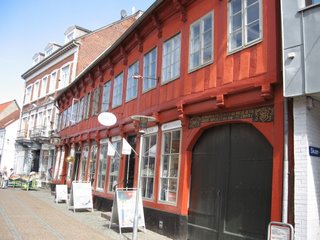 17th century house, Randers
17th century house, RandersDownstairs in "Elvis Unlimited" there is a shop selling back issues of fan club magazines, old Elvis records, photos, postcards and tee shirts. Upstairs is the museum of Elvis memorabilia and posters for his shows. It is the core collection from the Danish Elvis Presley Fan Club and even has a pair of his shoes – unfortunately not blue suede shoes, but white. As we explored the collection we were gently lulled by songs from his album Blue Hawaii. It was not well advertised in the town and we were almost the only visitors. Even Ian paid his 30 kroner for a look round. The best of the fun about it was that it had been collected so seriously by his Danish fans who would travel all over America to his concerts as evidenced by the many concert tickets and back-stage passes displayed in the exhibition. Sometimes Elvis would give their secretary one of his cast off sequined outfits and these would be worn by a club member at the next concert!
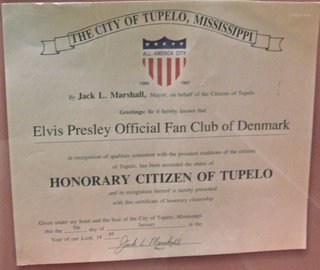 Proud memento for Elvis's Danish fans, Randers
Proud memento for Elvis's Danish fans, Randers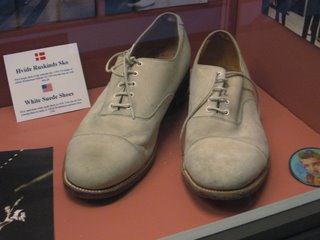 Elvis's white suede shoes, Randers
Elvis's white suede shoes, Randers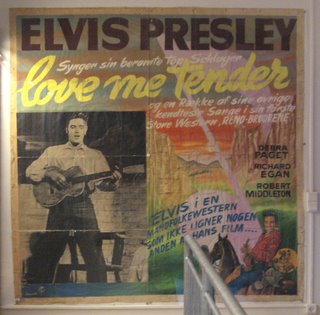 Danish Elvis poster, Randers
Danish Elvis poster, Randers Early Elvis publicity in Dutch, Randers
Early Elvis publicity in Dutch, Randers One happy fan, Randers
One happy fan, RandersHaving thoroughly enjoyed a morning of wallowing in nostalgia (well Jill had) we set off to explore the town. We were welcomed into the large, 15th century brick church of St. Martin by the elderly person on duty, who spoke excellent English though his deafness led to some interesting misunderstandings. This protestant church has a whitewashed interior and some very interesting monuments, paintings, chandeliers and carved wooden fixtures including a very impressive pulpit and a magnificent organ. It also has the oldest model ship to be found in any Danish church. It seems to be common practice here to commemorate ships, especially in coastal areas.
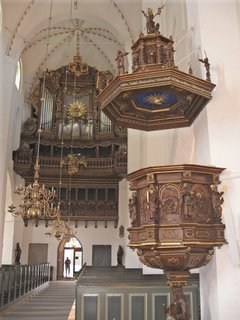 Church of St. Martin, Randers
Church of St. Martin, Randers Model ship dated 1632 in the church of St. Martin, Randers
Model ship dated 1632 in the church of St. Martin, RandersThe town's cultural centre houses the library, the art gallery and the museum as well as a smart restaurant with minimalist decoration in typical Danish style. Each table had a white cloth with a slim vase containing one poppy head. Crockery was plain white, chairs were very Scandinavian as were minimalist chrome light fittings. It was such a pity the aura of the room had to be destroyed by a couple of British pensioners who wanted coffees and rolls at one of the tables where white candles were burning brightly. Our snack lunch was nice but rather expensive. However, both the art gallery and the museum were free and an hour on the internet in the library cost us nothing.
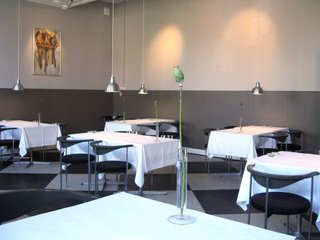 Danish design in the Cultural Centre café, Randers
Danish design in the Cultural Centre café, RandersThe art gallery contained both modern works and installations, most of which did not detain us for very long, and collections by local artists from the 19th century to date. These were more to our taste but the heat in the smart, Scandinavian building with its glass roof and large windows was quite unbearable. It could not have been pleasant for the staff working there. Why didn't the architect think through the whole thing when he designed the complex during a chilly Scandinavian winter?
 Danish flag in Lego bricks, 20th century exhibit in the art gallery, Randers
Danish flag in Lego bricks, 20th century exhibit in the art gallery, RandersThe museum on the floor below was marginally cooler and we spent ages exploring the exhibits which ranged from 100 years of electricity in Randers, through to archaeological exhibits and ancient rune stones. There were interiors of old businesses and houses displayed, furnished as they would have been at the time. Generally these tended to be furnished in heavy dark wood, crowded and cluttered, very different from the smooth, clean lines and sense of space seen in contemporary Danish interiors.
 19th century interior in the museum, Randers
19th century interior in the museum, RandersThe library in Randers was very smart, well stocked and with a number of innovative ideas including an automatic book sorting machine that classified the return books into order and arranged them ready for shelving by passing each book under a bar code scanner. The information required was all included in the bar code. Neat! All the staff spoke excellent English and explained how the sorter worked when we said we were English librarians.
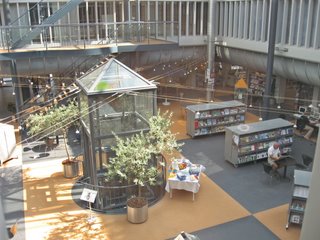 Public library in the cultural centre, Randers
Public library in the cultural centre, RandersWe were pretty exhausted by this time and it was really too hot for sight seeing. We walked down to the banks of the fjord where we found Randers' answer to the Eden project. This is a series of geodesic domes in which a tropical rainforest environment has been established. This must be a wonderful place to visit in the cold, dark, winter months but certainly not today.
We are very proud of our blossoming Danish. Once you start to crack a few words it is not so strange, frequently being rather like German or English. We read everything we see, guessing at the bits in between the words we can recognise. Sometimes this has funny results. Today we triumphantly turned up at what we thought was a spider museum, eager to see the large green pig spider. What could it be? We'd never heard of it. Neither had the museum staff. In fact it was a museum of Danish scouting and was full of toggles and woggles! Can't win them all! After that we decided not to take a wild guess at what the sign in the ladies wear shop meant by "Slutspurt." Sounds quite horrid!
 Prettiest Slutspurt Ian's ever seen! Randers
Prettiest Slutspurt Ian's ever seen! RandersDenmark is a land of trolls and Randers is a secret troll hotspot. They live underground and have small holes in the pavement through which they can reach to trip up passers by. Normally these holes are unnoticed and the trolls are rarely seen. However, if, like us, you are walking around searching for decorative manhole covers, you start to notice these little troll holes. They are not dissimilar in appearance to man holes but much smaller, just big enough for a corpulent little troll to squeeze his way out through. They are cheerful little chaps but as they don't tend to speak much English they shyly popped back underground when they saw us watching them.
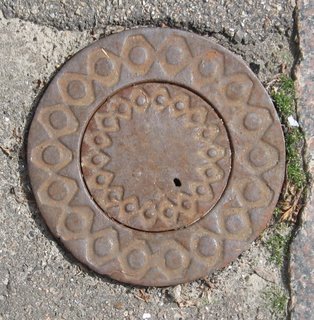 Troll hole cover, Randers
Troll hole cover, RandersAround 4pm we returned to Modestine and drove west and then north towards one of the campsites marked on our map. Denmark is really a collection of islands linked by bridges or narrow necks of land. Tonight we are at the southern end of the Limfjord, a huge stretch of water surrounded by tiny strips of land that hold back the waters of the Skagerrak to which it is linked by the tiniest of openings at Thyboren. It would be a very pretty area for a holiday but for us time is running out and we still have business in Norway to contend with. This campsite is not very busy at all. The lady here says the schools start back this week here! Strange when in England the holidays have not long started. Anyway that meant Jill had the swimming pool to herself and as nobody else was using the children's swings, slides, bouncy castle and climbing frame the campsite lady said it would be okay for us to play on them. The bouncy castle was particularly good but walking afterwards is not easy. After a game of mini-football where Jill won 6-2 we sat outside Modestine with a cold supper and glasses of wine until the sun set. Immediately though, the air cools down and it is quite chilly at night here. We have just been driven inside by the chill of the evening and the breeze from the fjord.
Wednesday 9th August 2006, Løkken, Jutland, Denmark
This evening finds us on the west coast nearing our destination of Hirtshals. We both feel very weary and surmise the cause to be the sea air. Gone is yesterday's heat and this evening there is even the odd spattering of rain. Actually we find this weather far more to our liking but being fairly flat the constant breeze blowing across the peninsula is very tiring. We are now on the most northerly of the islands that make up Denmark, a country of only five million people. We have been surprised at just how deserted the country is. It is sparsely populated, the roads are frequently empty and there is only a handful of towns of more than a few thousand inhabitants. We have now almost travelled the country from south to north. Since leaving Randers yesterday it has emptied out, leaving a land of ripe wheat fields waiting harvesting and a coastline of pale sand surrounded by a shimmer of bright sea. The light is very clear and bright and often the only activity to be seen is a cloud of dust from the harvesting machines as they cut an ever widening swathe around the fields, pouring grain from one end and chaff from the other. There are plantations of fir trees, and here and there areas of heath land with heathers, oak and beech trees, brambles and hawthorn bushes bent by the wind from the sea. The low sandy cliff tops are a riot of flowers even so late in the year with blue harebells, purple scabious and wild roses. Hedgerows are full of bright rosehips, crab apples, sloes and elderberries. Cattle graze right to the sea's edge, gulls soar on the constant wind and on the beaches there are signs warning visitors to avoid the young seals lying unprotected on the sand. We have been onto the beaches but have so far seen no seals.
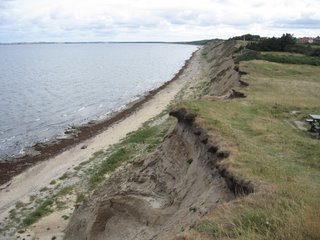 Sandy clifftops at Ertebølle
Sandy clifftops at Ertebølle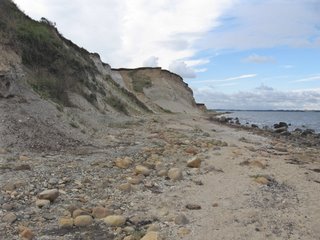 Beach at Ertebølle showing granite boulders deposited during the Ice age
Beach at Ertebølle showing granite boulders deposited during the Ice age Cattle grazing on the clifftops at Ertebølle
Cattle grazing on the clifftops at Ertebølle 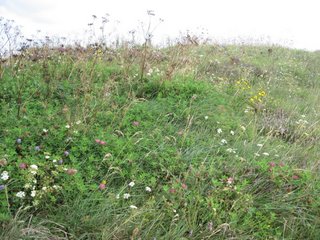 Flowers on the clifftop at Ertebølle
Flowers on the clifftop at Ertebølle Such was the landscape that greeted us this morning just a short distance from last night's campsite. There is here, as in other remote coastal extremes of the countries we have visited over the past year, a sense of quiet calm and timelessness. Here, as in Spain, Portugal and France, are the remains of Christian monasteries, remnants of an era when Christianity first reached the remote shores of Europe.
But here we have also seen many ancient burial mounds or tumuli. These are probably Bronze age as well as Viking. It could have been from these shores that the Vikings sailed on fishing expeditions and discovered Greenland. From here too they would have carried out their raids on the east coast of Britain. There is even a similarity in the feel of the landscape between northern Denmark and Northumbia both with their flat, sandy shores and remote fishing hamlets. Place names here show how the Danes influenced place names in England. Today we visited the peaceful wooded hollow of Naesby Dale leading down to the beach on the Limfjorden. Despite the name we have not popped back to Yorkshire for the day!
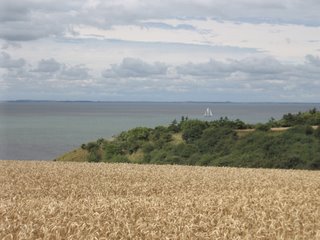 Limfjorden seen across the wheat fields from Naesby Dale
Limfjorden seen across the wheat fields from Naesby Dale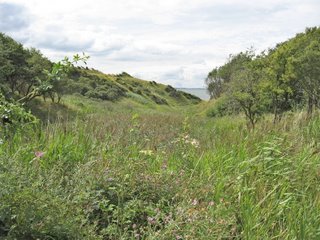 Naesby Dale
Naesby DaleVillages tend to be streets of low, single storey cottages, colour-washed, usually in yellow. Sometimes they are thatched with crossed wooden pegs along the ridge to hold the thatch in place against the winds, almost like hair pins!
We stopped to explore the cloisters and the remains of the old Cistercian monastery at Vitskøl on the shores of the Limfjorden, the huge salt water area, almost like a lake, in and around which the islands of northern Denmark lie. Here, sheltered from the sea breezes by surrounding woodland we could explore not only the broken walls of the 12th century church, but also a beautifully laid out and tended herb garden filled with aromatic, flowering herbs. There were mint, lavender, tansy, camomile, sorrel, parsley, thyme, rosemary, feverfew, fennel, chives, basil and many more. They were laid out in different, walled area according to their uses – culinary, cosmetic or medicinal. They were further arranged according to traditional usage – circulation, nausea, headaches and nerves etc. It is surprising how many are familiar to many English gardens without us being generally aware that they have these useful properties.
 Monastery at Vitskøl
Monastery at VitskølReturning to the entrance we were offered free mugs of coffee in the sunshine. This seems to be a pleasant custom in Denmark. Often there are trays laid for visitors to museums and public buildings to help themselves to drinks. There did not even seem to be a box for voluntary donations.
We have generally pottered today, taking the interesting looking byways in preference to the more direct routes. Both the countryside and the climate feel very much like parts of England, be it the more remote areas of Cornwall, or Yorkshire or Northumbria. There are elements of them all here. It does though, also have very much a Scandinavian feel. The wide vistas of land and water, the clear light, the dark green of the pine trees and the undulating landscape with its soft sandy soil. Scattered, and almost venerated around the countryside, can be found large granite boulders. There have presumably been carried south from Norway during the ice age, rounded and shaped on the way and finally deposited here. They are used as grave stones and plaques or cut into shapes for public monuments. They are generally incised. Most inscriptions are modern but these granite boulders were also used for runic inscriptions over a thousand years ago!
 Granite boulder shaped into a seal, Løgstør
Granite boulder shaped into a seal, LøgstørDuring the afternoon we arrived at Løgstør on the edge of that part of the Limfjorden known as the Løgstør Bredning or Broad. This is a very pleasant, completely uncommercialised little town with a harbour and a canal. It gives the impression that it is there to supply the needs of the entire surrounding countryside of isolated little hamlets and that everyone drives onto Løgstør every couple of weeks to stock up on foodstuffs and clothing. In the library we were told we could have free access to the internet. This seems to be the policy in Danish libraries. We did not need to be residents or even library members. It is the most open country we have visited with regard to the internet. In Italy we had to sign forms and show our passports for police checks before we were allowed on and everywhere else has been charged for. When it seems Denmark is expensive because of restaurant and supermarket prices, it often balances out with free museums, internet and coffees! House prices here seem much lower than in England too.
 Street in Løgstør
Street in Løgstør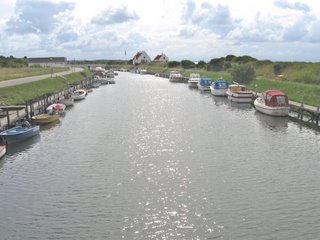 Løgstør canal
Løgstør canal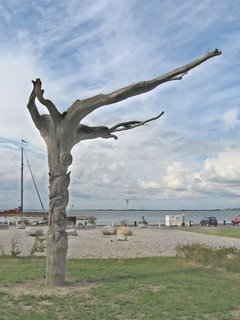 Carved tree in Løgstør
Carved tree in LøgstørLeaving Løgstør we crossed the bridge that links Vendsyssel, the most northerly of Denmark's islands, to the rest of the country, and drove on for a couple of hours before deciding to find a campsite. There are many around here, nearly all on the beach. This not very pleasant here, being windy with sand blown up everywhere. There are beach huts and caravan parks and generally we didn't like it much. However, we have found a site for the night back from the sea sheltered by woods and far more pleasant.
Thursday 10th August 2006, Skagen, Jutland, Denmark
It is a year to the day since we left England at the start of our "gap year". At the time we did not know quite how the year would work out and neither of us envisaged that we would spend as much time travelling in Modestine as we have. As far as we had any plans they were to use France as a base and to travel out for a few weeks at a time from there. In fact we have done far more. Denmark is our 16th or 17th different country and we are not finished yet. Today we booked a ferry place to Kristiansand in Norway. It has been a wonderful, exciting and happy year, the opportunity of a lifetime, and as our blog confirms, a year where every day has brought new surprises and experiences. There's an exciting and fascinating world outside of work with so much still to look forward to. It will be good to see family and friends again a few weeks from now, and to return to our own home for a while. But settling back will not be easy. Although we will probably not travel like this again, we certainly hope to explore more of the world while we are fit and healthy. We have never been so healthy! Not once during the year have either of us suffered more than a slight cold or a bruised foot despite the questionable hygiene standards of living, sleeping, eating, blogging and driving in a tiny camping car in all weathers!
This morning we made directly for Hirtshals, the northernmost ferry port of Denmark. From here the ferries leave each day for destinations in Norway, Sweden and Iceland, but not England. So with the help of charming, blonde, young Lars Larsen (what else?) in the ferry terminal we have booked a crossing for next week to Norway and will drive around the coast to Stavanger where we understand we can get a ferry across to Newcastle. That's the plan. When we were staying with Anne and Ray in Rohrbach a few weeks ago, one of Anne's English students told us of her wonderful Norwegian holiday along this same stretch of coast so we thought we'd investigate it for ourselves.
After that flurry of excitement this morning we set about exploring Hirtshals. We actually have very tenuous connections with the town and were hoping for the opportunity to make contact with Jill's cousin's in-laws. However, we do not have their family name to search the phone book and all relatives in England who could help us seem to be away on holiday. So, here at what definitely feels like the end of a continent, we have walked around the streets half expecting to see a familiar face. In any case, even if we had the family name we wouldn't find them. There are five million inhabitants of Denmark and there only seems to be about five surnames! There appears to only be about five given names too. Of course they combine in various different ways but it still leaves an average of one million people for each of the five surnames in the phone books! The odds of finding the one you want in Hirtshals are not high!
The town is not exciting. We are reluctant to say so but actually it is all rather boring. There are parades of small modern shops, none of which looked interesting. There are a few cafés and pizzerias, all serving rather mundane, boring meals – pizza, spaghetti, chilli con carne and burgers. Prices for meals are generally not cheap and it definitely does not seem the custom to eat out here. A few imaginative granite statues relieved the boredom of the place slightly. For us as visitors it was okay but it cannot be a stimulating place to live. It is famed for the quality of its light which is appreciated by artists. Today it was raining steadily so we could not share this appreciation. The sea front is nothing but sand and dunes and generally the town appears to exist because of the importance of the ferry port. It is also the town with the most dog fouled pavements we have encountered since we left the south of France.
In its praise though, it has a very good public library with free internet access. It is a cheerful, lively place, very well used, well laid out and designed. Just what English librarians expect from Denmark
When we couldn't think of anything more to do in the rain in Hirtshals we decided to drive to the very furthest tip of Denmark, Skagen, some 40 kilometres further up the coast. It was pouring with rain all the way. Up here the northernmost tip narrows to little more than a sandspit with dunes to either side. It is the point where the North Sea meets the Baltic.
So few are the tourist opportunities that a moving sand dune is something to remark on in all the guide books! So bored were we that it actually sounded exciting! Wow! Let's go look at a sand dune and see if it moves! We've four whole days before our ferry crossing and it's moving at the rate of 15 metres a year! That's SO thrilling!
Believe it or not, we couldn't even find the wretched thing! How out of date is our guide book if it's moved on already? Maybe our hearts were not quite in it but we gave up searching fairly quickly.
Leaving Modestine in the mizzle amongst the dunes at the very tip of Denmark we strode off past struggling Nordic walkers and old wartime bunkers on the beach, out along the sands to the point where the waters of the Skagerrak on the North Sea meet those of the Kattegat on the Baltic. The waves come from different directions and converge at one specific point where a shallow ridge of sand has built up. It is thus possible to stand astride the ridge with a foot in each of the two waters.
 Grenen sandspit and a wartime bunker seen from the dunes
Grenen sandspit and a wartime bunker seen from the dunes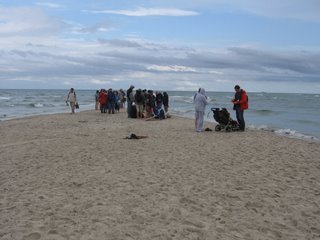 Sand, sea, sky and solitude – well almost! Grenen
Sand, sea, sky and solitude – well almost! Grenen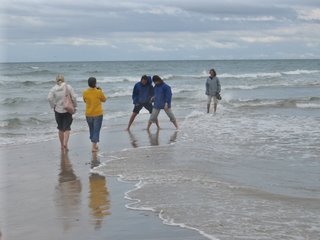 Right foot in the Skagerrak, left foot in the Kattegat, Jill at Grenen
Right foot in the Skagerrak, left foot in the Kattegat, Jill at Grenen Looking back towards Skagen from Grenen
Looking back towards Skagen from GrenenFor those too lazy or unfit to walk out there, a special sand bus will deliver them. After a quick glance passengers immediately huddle together in the damp wind waiting for the bus to return for them. At this point the land is far away, hidden behind the low line of white sand dunes. On all sides there is an endless sheet of grey, choppy water with perhaps a ferry on the horizon crossing to Oslo or Göteborg. Above, the sky is the same pale grey as the sea. The result is wonderful. There is a clear, bright light even on a dull day in the rain. No wonder this was the haunt of artists in the 19th century. The only mystery is what they actually found to paint! They flocked here in sufficient numbers though to establish a school of painting, similar to the Newlyn school in Cornwall. Here they painted endless seascapes, pretty girls in cotton frocks amongst the dunes and fishermen mending their nets or pulling in their boats. One of them, Holger Drachmann, is even buried amongst the dunes as his headstone testifies.
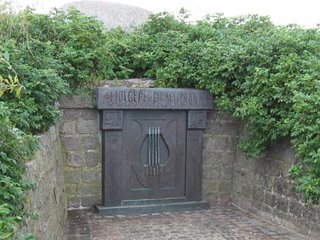 Grave of Holger Drachmann in the dunes at Grenen
Grave of Holger Drachmann in the dunes at Grenen The ever changing coastline leaves a bunker in the sea, Grenen
The ever changing coastline leaves a bunker in the sea, GrenenWe decided to investigate camping possibilities locally and are now on a site at the edge of the village of Skagen which we later explored on foot. It seems a pleasant little place, far more lively and interesting than Hirtshals with streets of pretty, low colour-washed houses in grassy gardens. Everywhere looks clean, smart, bright and cheerful. The centre of the town is pedestriansised and is busy with tourists. Here there are restaurants and cafés with terraces outside where you can enjoy a beer and watch the passers-by. Admittedly temperatures here have plummeted compared to Hungary and Germany so now drinkers huddle with their jackets on under the overhead heaters which are running at full pelt to keep them cosy!
On the main street there is a shop selling amber ornaments and jewellery. There was an amber museum but it appears to have closed. Amber has been gathered on the beaches around here for generations and used to form a useful second income for collectors. It is formed from hardened resin from pine trees, millions of years old and is washed up presumably from Norway. Sometimes there are insects preserved inside the translucent deep yellow-gold substance where they landed before the resin had set.
 Amber jewellery, Skagen
Amber jewellery, SkagenThe town also has a local history museum that we will investigate tomorrow. We have been trying to discover something about the Battle of Jutland during the first World War. So far we have found nothing mentioned but perhaps there is something in the museum. Other delights of Skagen include the church, locked this evening, that is painted in yellow and pink, reminding us of a Battenberg cake, and also a teddy-bear museum! It the rain continues until next Tuesday we might even be reduced to exploring the teddies as a way of killing the time! That's Denmark for you!
Thursday 10th August 2006, Skagen, Jutland, Denmark
We find ourselves back on the same campsite as last night but on a different plot. This morning we moved off and parked in Skagen intending to look around during the morning and move on later. However, we found far more to detain us than we anticipated and by the time we were ready to move on it was 5.30pm with the thunder clouds looming. So we returned to the campsite, booked in for another night and sat comfortably in Modestine with glasses of wine for an hour while the rain teemed down and thunder and lightening rolled around the skies.
This morning Jill woke with a headache and the sensation of only running at 90%. This is something that frequently happens before a storm but somehow the link is never made until the storm breaks. Driving off the campsite we nearly had an accident because of the difficulty seeing an approaching car from the right hand driving seat. Fortunately Ian gave a warning just in time but it shook us both rather. Jill was glad not to do much driving today with the headache that has continued most of the day.
For most of the day we have enjoyed bright sunshine with just enough of a breeze to make it comfortable. We wandered around the pretty yellow houses in Skagen with their steep, red-tiles roofs. Many are recent but built in the same style as those from the old fishing village. All are beautifully neat and attractive with white wooden fencing surrounding gardens filled with hydrangeas and hollyhocks.
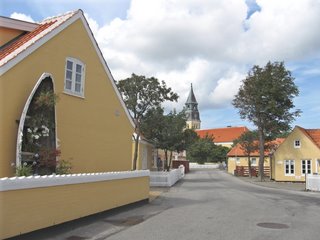 Street in Skagen
Street in SkagenGuided by the smell of fish we made our way to the port. Skagen is the largest and most important fishing port in Denmark. We were too late for the fish auction, the only remaining evidence being the piles of melting ice on the quaysides where the catches had been unloaded. Around the port were black wooden store houses, container lorries and nets and ropes laid along the quay to dry. To one side were fishing boats and dredgers, on the other expensive yachts moored to the quay with their owners and guests sipping drinks on deck as they sunbathed and chatted on their mobiles.
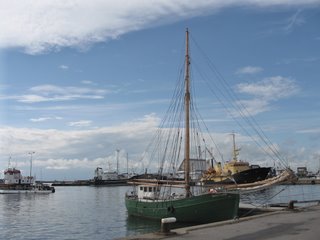 Fishing port, Skagen
Fishing port, Skagen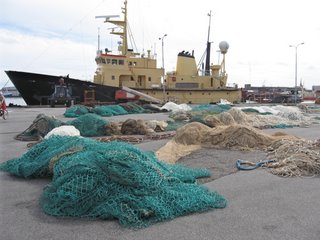 Fishing port, Skagen
Fishing port, Skagen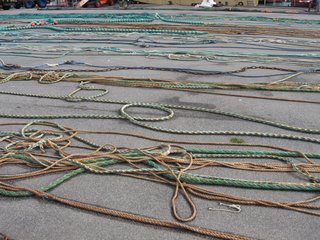 Ropes on the quay, Skagen
Ropes on the quay, Skagen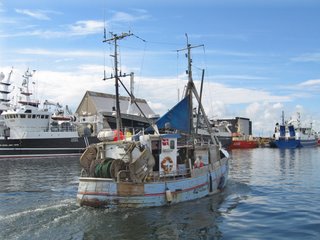 Fishing boat leaving harbour, Skagen
Fishing boat leaving harbour, SkagenStill with a headache and finding the glare on the quayside too much we explored a fish restaurant in one of the wooden warehouses. Empty at 10.30 in the morning the lady provided us with a couple of coffees and answered our questions about the different dishes on the menu in delightful English, with just enough uncertainty to make it sound really attractive. Displayed were sample dishes. All looked colourful, some rather strange. She did concede that the grilled squid and calamari were not actually caught in the North Sea but as they were popular they were brought up from Spain and the Mediterranean.
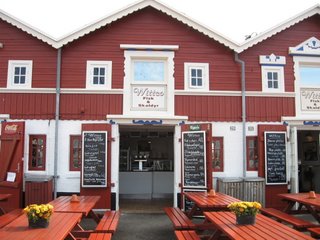 One of several fish shops and restaurants at the port, Skagen
One of several fish shops and restaurants at the port, SkagenPromising we would return at lunch-time we went off to explore further, checking up on the Battle of Jutland at the library. This took place in May 1916 off the west coast of northern Denmark. As it was between the British and German fleets and Denmark was not involved there is nothing mentioned locally that we can find. There were enormous losses on both sides and the result was indecisive. It apparently maintained Britain's supremacy at sea, Germany concentrating in future on submarine warfare.
At the Battenberg cake church, looking very pretty in the sunshine, we were just in time for a free lunch-time organ recital of music by Mendelssohn and Bach. It was well attended and provided a pleasant interlude in the cool interior of the church. The organ was modern and the church lacked the grandeur and wonderful acoustics of the cathedrals and major baroque churches of Austria but the recital was greatly appreciated by the audience.
 St. Lawrence church, Skagen
St. Lawrence church, Skagen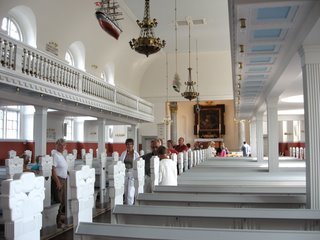 After the recital, Skagen
After the recital, SkagenWe returned to the harbour to find the fish restaurant tables outside packed now with holiday makers enjoying huge dishes of prawns, squid, fish and chips, smoked fish, tuna and mackerel. We ordered sea bass, deciding this was the place to try it really fresh. It came with lemon, parsley potatoes, fresh salad and hollandaise sauce. Ian ordered a beer as well but Jill's headache was still with her and not knowing if we would be driving later she stuck to water. The meal was really nice. We ate squashed together on tables with Danish holidaymakers. This gave us a chance to actually hear the language properly. Mostly it was incomprehensible but there are lots of English sounding words in there somewhere. The Danes are a friendly, cheerful lot.
The museum turned out to be a picture gallery of works by local artists of the 19th century. It was very enjoyable, being mainly the works of the Danish painters Anna and Michael Ancher and P.S. Krøyer. From the 1870s to the start of the 20th century Skagen attracted a new kind of artist, lured by the remoteness of the location and the clear light. They preferred to paint outside rather than in a studio and the nature of their paintings reflects this. Many are of seascapes or fishermen hauling in their boats or sorting their catch. There are many portraits, both of the local community, the fishermen and their families, but also of the artists' community, each painting portraits of the other. While many are trivial scenes of daily life, some reflect the anxiety and tragedy to be found in the hard and dangerous lives of the fishing community - fishermen on the shore helplessly watching a ship in difficulty or a family's grief around the table on which lies the drowned body of a fisherman that has just been brought home by rescuers.
Finally we visited the home of the artists Anna and Michael Ancher where many more of their painting can bee seen. The building is typical of Skagen being single storey yellow rendered brick and timber set in a large green garden.
 Gallery at the former home of Anna and Michael Ancher, Skagen
Gallery at the former home of Anna and Michael Ancher, SkagenBy this time we were weary and the sky was threatening, so we returned with Modestine to the camp site just as the storm finally broke.
